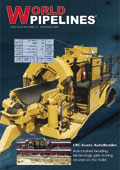Editorial comment
For those readers who are celebrating Christmas in a couple of weeks, I hope you’ve been good this year – otherwise legend has it that Father Christmas will deliver you a lump of coal, instead of the gifts you’ve been hoping for. Personally, I’m not so sure that coal is such a bad gift to be given. This week I’ve been reading about unconventional oil and gas - new ways to extract energy using innovative production methods - and working with coal is one of these ways.
Register for free »
Get started now for absolutely FREE, no credit card required.
Oil can be wrested and refined from sticky tar sands, extracted from oil shale via underground heating methods, or produced by coal-to-liquids (CTL), or gas-to-liquids (GTL) technology. Gas can be collected from coal seams, fractured out of shale, freed from tight gas formations or released from methane hydrates trapped in ice. These new technologies have huge implications for the energy world. Unconventional natural gas constitutes a large proportion of the gas reserves that are yet to be exploited in North America, and around the world, and its existing contribution to the global energy mix is set to increase as easier-to-access reserves dwindle.
One piece of this story interests me particularly, and that’s the potential for CTL, in which liquid fuel is made by heating coal and catalysing the resultant carbon monoxide and hydrogen, producing diesel and kerosene. Coal is plentiful and the fuels produced are of a high quality, but the costs are high, both in financial and environmental terms. It takes approximately 2 t of coal and 15 barrels of water to produce a single barrel of synthetic fuel. In addition, CTL fuels have double the carbon emission of conventional crude.
Here, carbon capture and storage (CCS) can help. CCS consists of the separation of carbon dioxide (CO2) from industrial and power plant sources, transport to a storage location and long-term isolation from the atmosphere.
In the US today there are 3000 - 4000 miles of CCS pipelines, developed to transport CO2 for Enhanced Oil Recovery. This network could be expanded to provide for carbon sequestration operations. CO2 pipelines are physically similar to natural gas pipelines, although they are more likely to be used at higher pressures, and would have electric compression or pumping facilities rather than gas-fired compression. CO2 pipelines do not corrode faster that natural gas pipelines, and build costs should be on a par as well.
In Canada last week, the Alberta government signed a letter of intent with Enhance Energy to construct a 240 km CO2 distribution system, which will be the largest CO2 pipeline in the world. The Alberta Carbon Trunk Line (ACTL) has been awarded Cdn$ 495 million over 15 years from the provincial government, as well as Cdn$ 60 from the Government of Canada’s ecoENERGY Technology Initiative and Clean Energy Energy Fund. Elsewhere last week, the European Commission held the preparatory meeting for its new knowledge-sharing network of CCS demonstration projects. The meeting gathered delegates from 22 projects in 13 European countries. The venture is co-ordinated by DNV.
To further the development of CCS pipelines, it’s a case of developing the technology to free and transport these vital resources and their by-products, and then getting the regulatory and tax legislation in place to facilitate growth in the sector.
The ‘resource triangle’ theory – developed in the mid 1970s by Master and Grey, and subsequently furthered by Steve Holditch, currently Professor of Petroleum Engineering at Texas A&M University, holds that oil and gas resources are ‘log normal’ like any other mineral resource. This means that, typically, the harder a resource is to extract, the greater will be the available resource. These unconventionals therefore hold much potential, even as the game gets harder. The saying goes: 'In all human affairs there are efforts and there are results, and the strength of the effort is the measure of the result'. Season’s greetings from all at World Pipelines, we wish you the very best efforts, and results, in the New Year.


